

 STUART JORDAN looks at the development of this family of high-speed trains.
STUART JORDAN looks at the development of this family of high-speed trains.
The genesis of the British Rail Class 800 was in 2005. The Department for Transport (DfT) wanted a replacement for the aging Intercity 125 fleet and, in 2007, launched the Intercity Express Programme (IEP). This project would seek a new high-speed train to run on the East Coast Main Line and the Great Western Main Line.
The specifications were for three versions – overhead line powered, self-powered, and ‘bi-mode’. The train was to be between 130m and 312m, with the ability to easily lengthen and shorten the trains with a coupling/uncoupling time of 180 seconds or shorter. The bi-mode version was required to be able to switch power supply while both stationary and moving at any speed. The minimum top speed was to be 125mph or more.
The tender was put out to three short-listed companies: Alstom-Barclays Rail Group, Express Rail Alliance (a consortium made up of Angel Trains, Babcock & Brown, Bombardier, and Siemens), and Hitachi Europe. Alstom withdrew from the process and Barclays re-joined as a partner with Hitachi, under the name ‘Agility Trains’.
This move caused some controversy, as Agility Trains were announced by the government as the preferred bidder. Unions and local MPs saw this as taking jobs away from British workers at the Bombardier factory in Derby, whereas the Japanese railway market is so closed off to foreign manufacturers. After the £7.5bn contract was announced, Hitachi confirmed that pre-production bodyshell construction would be carried out in Japan, with the final assembly completed at a site in the UK.
The design produced by Agility Trains (the ‘A-Train’ family of designs) was the Hitachi Super Express Train. A hybrid traction system was proposed, with trains in either ten or five coach units. The coaches were to be 26m long, which is 3m longer than the British Rail Mk3 and Mk4 Coaches used by existing high-speed services. The Hitachi would also consume 15% less fuel than the 125. By 2010, the order had changed; modified by factors such as the economic downturn and the expected full electrification of the Great Western Main Line. The order was reduced from 850 coaches to 770 and the diesel-only plans scrapped.
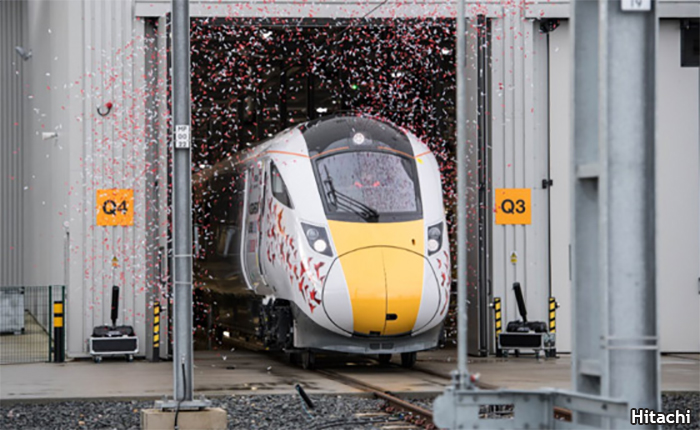
The first 800 rolls off the production line at Newton Aycliffe.
Newton Aycliffe in County Durham was chosen as the location for the new assembly plant, and it was officially opened by Prime Minister David Cameron in September 2015. The site employed 1000 staff in 2017, scaled down to 700 in 2020. The plant was also later used to construct the Class 385 for Abellio ScotRail. Maintenance depots for the 800 were built at London North Pole (previously a Eurostar depot), Stoke Gifford, Swansea, Bounds Green, Doncaster, Craigtinny, and Neville Hill TMD.
The first train left Hitachi’s Kasado factory in January 2015, shipped from Kobe to Southampton arriving in March. The first unit, 001, underwent trials at the Old Dalby Test Track later that year. The first 800s went into service on the Great Western Main Line on 16th October 2017. There were problems on this first journey between Bristol to London, with the train running late and an air conditioner unit malfunctioning, but these problems were soon overcome.
The introduction of the Class 800 onto the East Coast Main Line was delayed from 2018 to 2019, due to electro-magnetic emissions from the units causing interference with lineside equipment. As Virgin Trains had handed back the franchise for the ECML, the trains went into service with the DfT-run London North Eastern Railway.
The GWR units are branded Intercity Express Train (IET), whereas the LNER run the 800 as ‘Azuma’, the Japanese word for ‘East’. Many of the GWR IETs are named after inspirational people from the area that GWR covers.
Unit 800104 was named ‘Celebrating Scotland’ and ran on the first Azuma services from Edinburgh to London Kings Cross, and the first services to Aberdeen and Inverness.
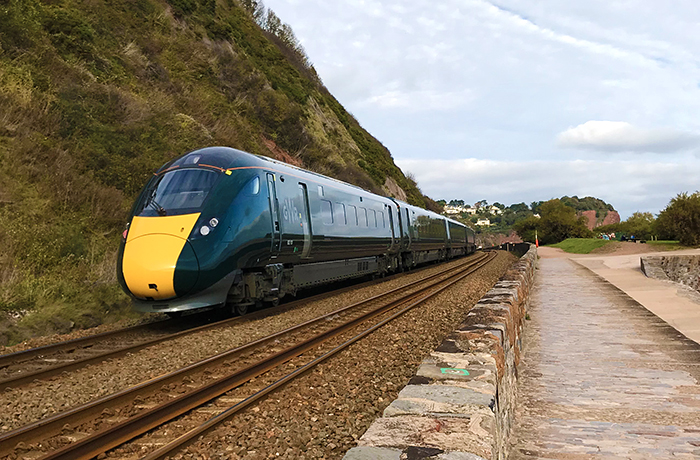
GWR 802/1 IET heading down the Devon Coast at Teignmouth.
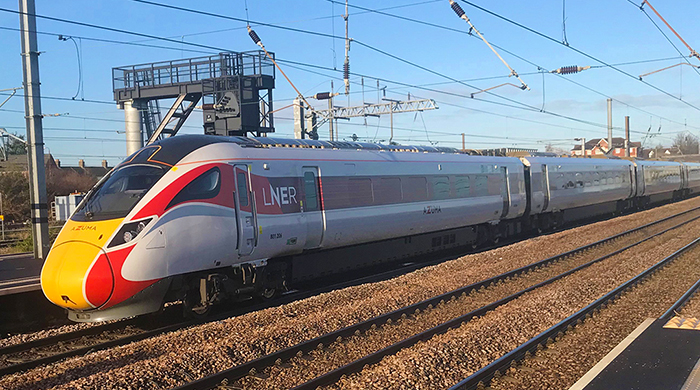
GWR 801/2 Azuma at Peterborough.
Other companies besides GWR and LNER are already running, or set to start running, their own variants of the Class 800. For completeness, here is a list of current and future operators of trains from the AT300 family.
800/0 GWR Intercity Express Train (5 Coach Bi-Mode) - In Service
800/1 LNER Azuma (9 Coach Bi-Mode) - In Service
800/2 LNER Azuma (5 Coach Bi-Mode) - In Service
800/3 GWR Intercity Express Train (9 Coach Bi-Mode) - In Service
801/1 LNER Azuma (5 Coach EMU) - In Service
801/2 LNER Azuma (9 Coach EMU) - In Service
802/0 GWR Intercity Express Train (5 Coach Bi-Mode) - In Service
802/1 GWR Intercity Express Train (9 Coach Bi-Mode) - In Service
802/2 TransPennine Express Nova 1 (5 Coach Bi-Mode) - In Service
802/3 Hull Trains Paragon (5 Coach Bi-Mode) - In Service
803 East Coast Trains (5 Coach EMU) - Due to commence service October 2021
805 Avanti West Coast (5 Coach Bi-Mode) - Due to commence service 2022
807 Avanti West Coast (7 Coach EMU) - Due to commence service 2022
810 East Midlands Aurora (5 Coach Bi-Mode) - Due to commence service 2023
The 801 is the classification for the purely electric-powered version of the 800 for use on the ECML, but each unit still has a diesel engine in case of emergencies.
The 802 is identical to the 800 Bi-Mode versions, but due to Newton Aycliffe being at capacity they were constructed at Hitachi’s plant in Pistoia in Italy.
803 is also a version of the 801, constructed for East Coast Trains, but does not have the emergency diesel engine. Instead, it has batteries to maintain onboard services in case of power failure.
Class 805 and 807 are the Avanti West Coast versions of the Bi-Mode and EMU units.
Class 810 is the EMR Aurora which is destined to begin services on the Midland Main Line in 2023. This Bi-Mode version is an 802 with a modified design – it has to be Bi-Mode as the planned electrification of the MML north of Bedford was paused.
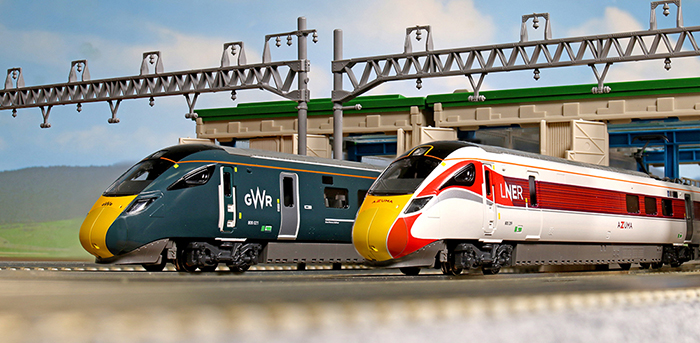
Due to arrive in May/June 2021, these two new N Scale (1:148) 5-car train packs are sure to be popular with modern image modellers. A companion Starter Set for each livery will also be available in the Gaugemaster Collection.
The model will feature:
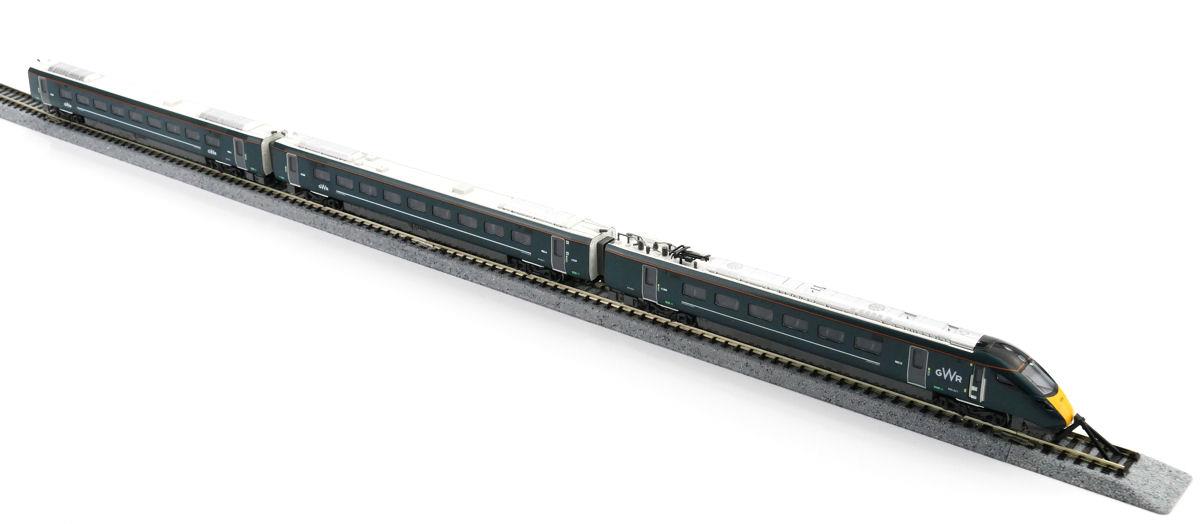
We are delighted to be able to present this iconic train, made by the legendary Japanese manufacturer KATO, a world leading company in the world of N Scale model railways. We’d also like to thank Hitachi, GWR, and LNER for their helpfulness and assistance in bringing this project to market. Each unit will be available as a 5-car pack from Kato, as well as a Premium Starter Set in the Gaugemaster Collection.
K10-1671 Class 800/0 GWR IET 800 021 5 Car EMU
K10-1674 Class 800/2 LNER Azuma 800 209 5 Car EMU
GM2000103 GWR Class 800 IET Premium Train Set
GM2000104 LNER Class 800 Azuma Premium Train Set
A wide selection of spares will also be available, as well as a digital decoder set.